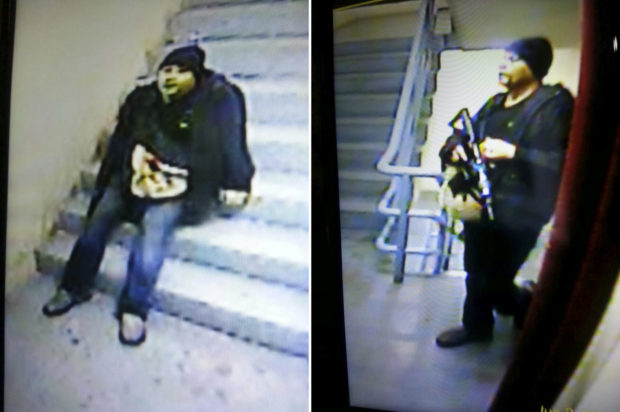PNP still searching for clues on Resorts World gunman’s identity

This image made from closed circuit television made available by the Philippine National Police on Friday, June 2, 2017, shows the gunman at the Resorts World Manila complex in Manila, Philippines. A gunman stormed a casino in the Philippine capital and torched gambling tables in the crowded space, creating a choking level of smoke that killed dozens, authorities said. The gunman stuffed a backpack with casino chips before he fled but was found dead in an adjacent hotel early Friday. (Philippine National Police via AP)
Philippine authorities said Saturday they still did not know the identity of the gunman who killed 37 people when he torched a casino, but insisted he was not an Islamic State group terrorist.
The masked man stormed into the Resorts World casino and hotel complex in the capital of Manila on Friday with an M4 automatic rifle and a bottle of petrol, before setting alight one of the main gaming rooms.
READ: Terrorism ruled out in Resorts World attack; gunman stole casino chips
Thirty-seven people died in the fire, dozens more were injured in a stampede to escape, and the gunman was found dead about five hours later in a hotel room after committing suicide by setting fire to himself, police said.
IS claimed responsibility, with a report on its self-styled Amaq news agency saying its “fighters” carried out the attack, but Philippine authorities continued to insist Saturday that a mentally disturbed man had been attempting a bizarre solo robbery.
Article continues after this advertisement“They (IS) may claim credit but, according to evidence, it is not so,” presidential spokesman Ernesto Abella said.
Article continues after this advertisement“The evidence at this stage points to the actions of an emotionally disturbed person who was apparently engaged in criminal actions.”
However National Capital Region Police chief Oscar Albayalde told Agence France-Presse on Saturday they did not know who the gunman was.
“None yet,” Albayalde said in a text message when asked about any leads on the identity of the gunman.
Albayalde also added to a bewildering array of contradictory messages from authorities in the initial stages of the investigation by saying police now believed the gunman had arrived at the casino in a taxi.
“We have the taxi driver (who dropped off the gunman) already,” Albayalde said, without elaborating.
But Albayalde and other police chiefs said repeatedly throughout Friday that recorded security footage showed the gunman drove to casino and parked his vehicle in the complex’s car park.
“The CCTV (footage) shows that he parked his car, took out his gun and directly went inside Resorts World,” Albayalde said on Friday.
There was no explanation from police on Saturday for the change in such a crucial part of the investigation.
Confusion
Police had also given confusing or contradictory statements on other key parts of the incident on Friday.
National police chief Ronald “Bato” dela Rosa initially said police had shot dead the gunman, but then later reported the assailant wrapped himself in a blanket and burnt himself to death.
READ: Resorts World gunman burned self to death–PNP
Dela Rosa also said the gunman had not shot anyone, but Resorts World reported one of its security guards had suffered a gunshot wound.
Albayalde said Friday that the assailant was likely a foreigner, describing him as a caucasian who spoke English.
He and Dela Rosa said the man was trying to rob the casino, saying he fired at a stock room containing gambling chips and filled a backpack with chips worth 113 million pesos ($2.3 million).
But they said the man left the backpack in a bathroom after filling it up.
President Rodrigo Duterte imposed martial law last week across the southern region of Mindanao to crush what he called a rising threat from IS.
He made the move shortly after local militants who have declared allegiance to IS went on a rampage through the city of Marawi, about 800 kilometers (500 miles) south of Manila.
Security forces are still battling the militants in Marawi, and the clashes there have left at least 175 people dead.
A Muslim separatist rebellion in the south of the mainly Catholic Philippines has killed more than 120,000 people since the 1970s.
The main Muslim rebel groups have signed accords with the government aimed at forging lasting peace, giving up their separatist ambitions in return for autonomy.
However a range of hardline groups have rejected the peace process and in recent years sought to unite behind IS.
Duterte said last week he might declare martial law across the rest of the country if the terrorism threat spread.
The US embassy in Manila has issued a number of advisories in recent months advising Americans to avoid large parts of the central, southern and western Philippine because of the risk of being kidnapped by the militants.